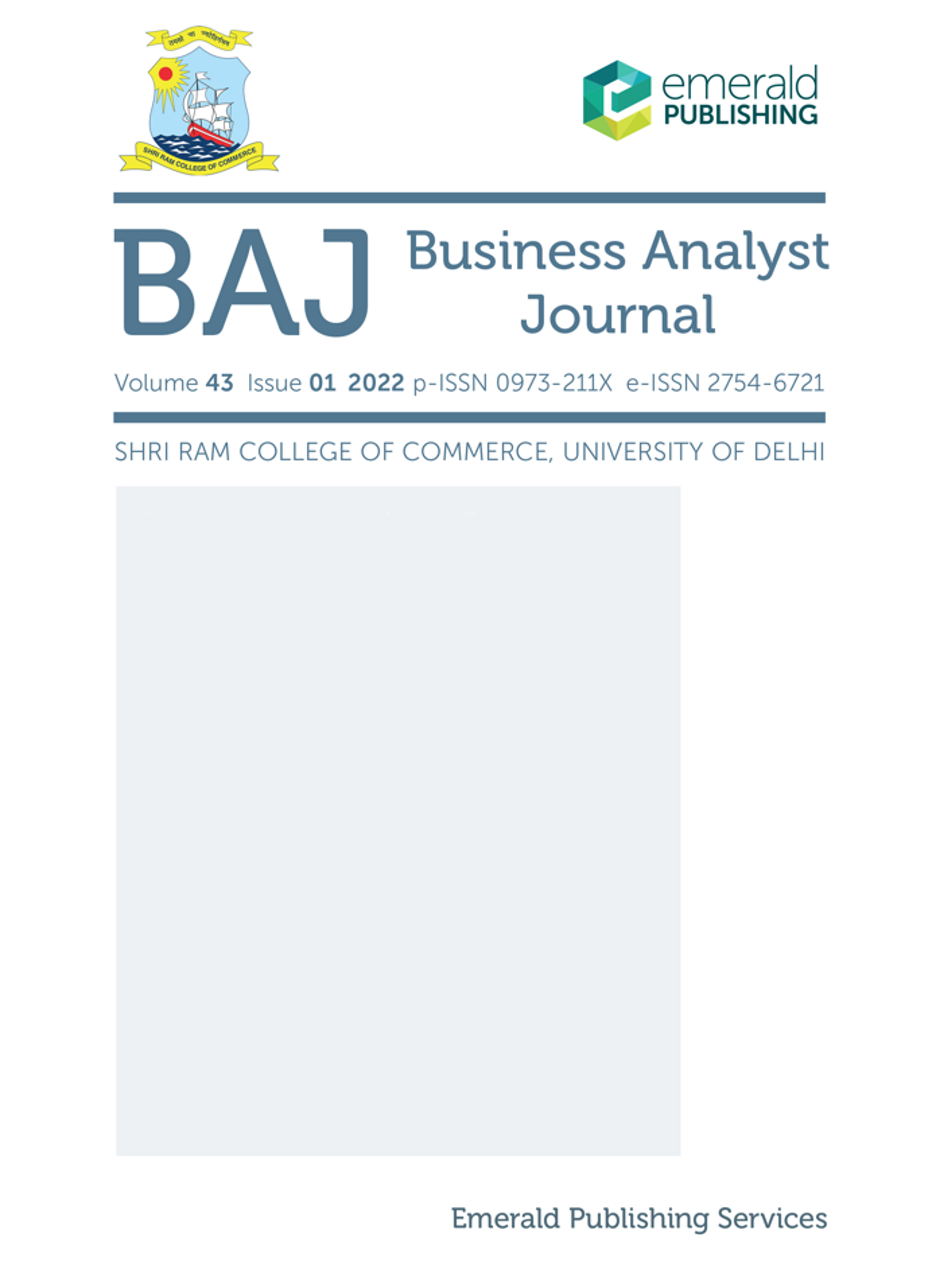Measuring the Attitudes and Behavioural Dynamics of Consumers towards Online Shopping amidst Covid-19: Insights from Kolkata
Samuel S Mitra, Shivaji Banerjee, Peter Arockiam. A., Joseph K.
Volume 42, Issue 2 (July 2021 to December 2021)Abstract
Download ArticleThe past few years has witnessed the phenomena of “internet shopping” grow in leaps and bounds. The term “online shopping” has become a buzzword and an ever growing trend among consumers even in a developing country like India. In fact, the market potential for e-commerce has a huge reservoir as explored through a sneak-peek into the exponential expansion of key players existing in the e-commerce industry. Moreover, online shopping has prodigiously influenced the lives of the modern day consumers, who have been observed to have a penchant towards it. The present research endeavour is aimed to probe into the perceptions of consumers towards e-shopping in the context of “Technology Acceptance Model” (TAM). For this purpose, a survey among 363 respondents in the metropolitan setting of Kolkata has been conducted and their responses were recorded. “Structural Equation Modeling” (SEM) has been used to examine and analyze the model fits and hypothesis testing. The findings reveal positive perception among the surveyed consumers towards online shopping.
Relationship between Brand Experience and Brand Loyalty, Mediators – Satisfaction and Brand Trust: A Conceptual Framework
Ruchika Ramakrishnan
Volume 42, Issue 2 (July 2021 to December 2021)Abstract
Download ArticleThe term “experiential view” encompassing fantasies, feelings and fun associated with the consumption of goods and services was visibly introduced in marketing literature by Holbrook and Hirschman (1982). Since then, the concept has evolved from “consumption experience” to “customer experience” and recently to “brand experience”. This study has made an attempt to understand its relationship with brand loyalty. The importance of brand loyalty in ensuring a brand’s survival and growth is universally accepted. The other two variables- satisfaction and brand trust- have been included as the mediating variables in this study. A mediating variable is a variable that plays a causal intermediary role between an independent variable and a dependent variable. This paper covers the literature review and operationalisation of these four variables.
Bank Monitoring as an Alternative Corporate Force and its Impact on the Value of Borrower Firm
Neeraj Kumar, Madhu Vij, Narain
Volume 42, Issue 2 (July 2021 to December 2021)Abstract
Download ArticleWe have analysed the effectiveness of monitoring by banks as a tool of corporate governance and the impact it has on the value of the borrowing firms. We used three indicators as proxies for strong bank monitoring on a company- a) substantial ratio of bank debt to overall debt, b) borrowings from private banks and c) sizeable banking relationships. A dataset comprising Indian non-financial companies from years 2003-2018 was used in our panel-data regression models. We considered a robust sample size of observations, consisting ~2269 firm years from public as well as private organizations. The result outcomes from our study show that all the three measures significantly impact the value of the borrower firm. However, while the share of bank borrowing as well as the type of banker are significant factors that have positive influence on the value, the number of different banking relations has an inverse impact on the same. Borrowing from multiple banks leads to drop infirm value, proving that a single bank relationship is stronger means of corporate governance as it mitigates any "free-rider" problems. This indicates that only the banks with high quality active monitoring play a key governance role, thus improving firm value.
Liquidity Aggregates in India: An Empirical Analysis of Recent Trends
Ritu Ranjan
Volume 42, Issue 2 (July 2021 to December 2021)Abstract
Download ArticleThe present paper empirically analyses the recent trends in real growth rates of various components of liquidity aggregates in India over the period December 2019 to April 2021. The results of breakpoint unit root test involving the application of innovational outlier model and minimisation of Dicky-Fuller t-statistic clearly establish a “structural break” in the real growth rates of both M3 and L2 thereby bearing testimony to the adverse liquidity conditions prevailing in the Indian economy. The future course of Indian economy crucially hinges on how well the monetary authority handles this formidable challenge.
Impact of Dividend Decision on Company Performance: An Empirical Study of Select Nifty-50 Index Companies
Haritika Chhatwal, Rachna Mahalwala
Volume 42, Issue 2 (July 2021 to December 2021)Abstract
Download ArticleThe dividend decision of a public listed company is vital for its various stakeholders as it is considered a yardstick to judge the financial performance of a company and its earnings generating capacity. However, the existing theoretical framework and previous empirical research relating to the effect of dividend decision on the firm's financial performance do not indicate a straightforward cause and effect relationship between the two. The present study examines the impact of dividend decision on company performance by taking a sample of listed companies on Nifty 50 index for the period 2013-14 to 2020-21. The technique of panel data regression with Pooled Least Square Estimation, Fixed Effects Model and Random Effects Model is adopted to examine the said relationship empirically. The study results find support for relevance theories, specifically bird-in-hand and signalling theory. The results establish a positive impact of dividend payment on company performance. The study results will be helpful for finance managers in determining dividend policy and for investors for making apt investment decisions.
Consumers’ Level of Organizational Trust When Buying From Locally Owned Businesses vs. Corporations
Andy Bertsch, Mohammad Saeed, James Ondracek, Joanna Claire Miranda, Tyler Boettcher, Briley Crissler, Jacob Burckhard, Tanner Crissler, Joshua Drew
Volume 42, Issue 2 (July 2021 to December 2021)Abstract
Download ArticleThis paper explored the consumers’ level of organizational trust in deciding to buy from local businesses versus from corporations. This was done by investigating benevolence and integrity as constructs of trust and explored the impact of affective commitment. This paper also explored if demographics namely gender, education level, age, employment status and year in school (if they are currently attending school), had any impact on the consumers’ benevolence, integrity and affective commitment. The result of this study showed that gender did not affect the decision to purchase from local business or from corporation. Age and educational level also did not have any impact of purchase decisions. However, employed participants were committed to businesses that they frequented. Participants who felt that customer service and customer reviews were important felt a higher level of affective commitment towards businesses that they frequented.
Book Review on "Money: What it is, How it's Created, Who Gets it, and Why it Matters
Annavajhula J C Bose
Volume 42, Issue 2 (July 2021 to December 2021)Abstract
Download Article



